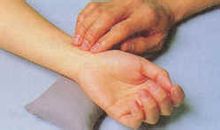pulse diagnois
In TCM, pulse diagnosis is a mysterious craft. Fine consecutive steps of a complete set of programs, it is like a grand ceremony. Pulse formation is closely related to zang fu, qi and blood. The heart dominates the veins; the lung dominates all the meridians, spleen dominates the blood, liver reserves blood, kidney essence transforming into blood, can all lead to the changes of pulse, so different pulse reflect physiology and pathological changes in the zang fu organs. The perfect pulse taking time is at sunrise, one should keep cool and calm, breath smoothly so the pulse can be implemented accurately.
Finger technique of pulse diagnose
The finger technique of pulse diagnose is very important for doctors as proper finger technique would get them rich pulse information. Main points of Finger technique of pulse diagnose can be summed up as three fingers stay parallel;the middle finger diagnoses Guan pulse;the index finger diagnoses Cun pulse;the wedding finger diagnoses Chi pulse.

Factors of pulse manifestations:
Essential factors of pulse manifestations generally include four aspects as Wei, Shu, Xing, Shi.
Wei: represents three parts: Cun pulse, Guan pulse and Chi pulse. Normal pulse positions are neither floating or sunken, so there are pulses being diagnosed on the three parts. For example, shallow position pulse is called floating pulse;pulse position which is further than Cun, Guan, Chi positions is known as long pulse;pulse position that is too short to reach the position of Chi, Cun position is short pulse.
Shu: refers to the pulse frequency.
Xing: refers to the size of the pulse, soft and hard degree.
Shi: it is to show the strength and fluency of the pulse.
Diagnosis
Depending on the pulse manifestations, pulses can be divided into floating pulse, sunken pulse, retarded pulse, frequent pulse, pulsus vacuus, replete pulse, slippery pulse, pulsus plenus, microsphygmy, angry pulse. Floating pulse belongs to yang, generally consists of six climate factors – wind, cold, damp, dryness, hot, heat. Sunken pulse belongs to yin, representing internal diseases, is driven by seven emotions--joy, anger, anxiety, worry, sadness, fear, shock.
Influencing factors:
Pulse amanifestations are closely related to seasonal change, age, gender, body constitutions, the work and rest conditions and also mental state, so diagnose should pay particular attention to identifying pulse. In four seasons, angry pulse in spring, full pulse in summer, floating pulse in autumn, sunken pulse in winter are all common changes of the pulse.
The young have faster pulse; babies’ pulse are quick, young men’s pulse are more powerful, women's pulse are weaker and slightly faster than that of men; After physical work, alcohol drinking, full diet or being excited,thel pulse beats faster and more powerful while under hunger condition the pulse is obviously weak; Fat men have sunken pulse and thin men have floating ones; Mental workers’ pulsed are weaker than physical workers, etc.